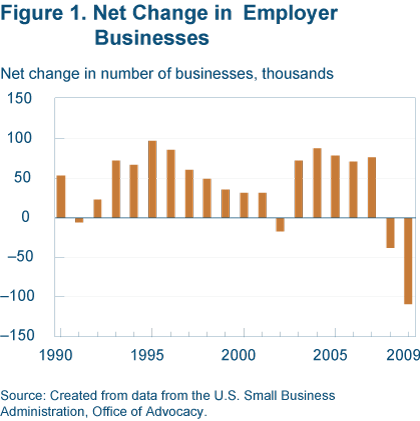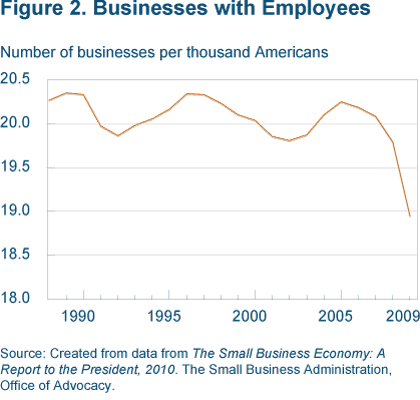The Great Recession’s Effect on Entrepreneurship
Though the recent recession was the worst downturn since the Great Depression, some observers argue that one silver lining is an upswing in entrepreneurship. Recessions, they claim, provide laid-off workers with the motivation to start their own businesses, and a recent study suggests that in 2009 the number people becoming self employed spiked to its highest level in more than a decade. Unfortunately, a careful look at multiple sources of data shows that the Great Recession was actually a time of considerable decline in entrepreneurial activity in the United States.
Between December 2007 and June 2009, the United States suffered its biggest economic downturn since the Great Depression. Dubbed the Great Recession, this economic contraction saw gross domestic product decline 4 percent and the unemployment rate more than double from 4.9 percent to 10.1 percent.
While the media was full of reports about how the recession affected big business and consumers, it was largely silent on what happened to entrepreneurship. Economists are divided on the matter.
Some believe that recessions have no effect on entrepreneurial activity, arguing that the negative effects of reduced demand are offset by the increased motivation to have one’s own business as a protection against layoffs.1
Others believe that the Great Recession actually brought about an upswing in entrepreneurship, as the downturn pushed laid-off workers to pursue their entrepreneurial dreams. A press release announcing a recent report from the Ewing Marion Kauffman Foundation, for example, went so far as to argue, “Rather than making history for its deep recession and record unemployment, 2009 might instead be remembered as the year business startups reached their highest level in 14 years—even exceeding the number of startups during the peak 1999–2000 technology boom.”2
Unfortunately, a careful look at the data suggests otherwise. Multiple sources of government and private data show that the Great Recession was actually a time of considerable decline in entrepreneurial activity in the United States.
Self-Employment Fell
No single measure captures entrepreneurial activity perfectly. However, by looking at several different measures, we can piece together the big picture and use it to see how entrepreneurship fared during the Great Recession.
Self-employment is one variable that economists use to measure entrepreneurship, as the self-employed are in business for themselves. The wage-employed, in contrast, work for others. As a statistic, self-employment has the advantage of measuring what happens to the widest range of entrepreneurs because it includes people starting corporations with employees as well as those starting sole proprietorships without employees.
The rate of transition into self-employment did in fact increase during the Great Recession. The Kauffman Index of Entrepreneurial Activity,3 which uses information from the Current Population Survey (CPS) to measure the percentage of the adult, non-business-owning population that starts a business each month, shows that the number of people between the ages of 20 and 64 who became selfemployed each month on average rose from 300 per thousand people in 2007 to 340 per thousand in 2009.
However, transition into self-employment is only part of the story. Many people who were self-employed before the recession exited during the downturn. Data from the Bureau of Labor Statistics (BLS) show that the rate of exit from self-employment must have increased even faster than the rate of entry into it because the stock of self-employed Americans fell during the Great Recession. BLS data reveal that the seasonally-adjusted number of unincorporated selfemployed Americans—the only measure of self-employment that adjusts for seasonality—fell from 10.2 million people in November 2007 to 9.8 million people in June 2009.
The adverse effect of the Great Recession on employment was slightly worse for self-employed people than for those who worked for others. From December 2007 to June 2009, the number of self-employed people fell 4.4 percent, while the number of wage-employed people dropped 4.3 percent.
Another view of entrepreneurial activity can be obtained by comparing numbers on incorporated and unincorporated self-employment. That comparison lets us tease out how the recession affected two different kinds of people who work for themselves—those who run corporations and are likely to employ others and those who don’t, mostly sole proprietors less likely to have employees. Both types of self-employment fell during the recession, but the decline was much more severe for those running corporations. BLS numbers show that (nonseasonally adjusted) incorporated self-employment dropped by 519,000 people between November 2007 and June 2009, a reduction of 8.9 percent, while (nonseasonally adjusted) unincorporated self-employment fell by 48,000 people, a decline of 0.5 percent.
This pattern has important implications for the question at hand. Corporations have more of an economic impact in general than sole proprietorships. The pattern in the BLS data suggests that the more substantial type of entrepreneurial activity was more adversely affected by the recession than the less substantial kind, a pattern that is confirmed by other sources of data.
Many Employer Firms Disappeared
Some economists believe that entrepreneurship is best measured not by self-employment, but by the number of people who own and operate businesses. Therefore, understanding what happened to the stock of employer firms during the Great Recession is important for assessing the impact of the recession on entrepreneurial activity.
The U.S. business stock is composed of two types of firms: employer firms, which, as the name suggests, have employees, and nonemployers, which do not. Nonemployer firms are more common—80 percent of U.S. businesses have no employees, according to Census Bureau estimates—but they have far less economic impact. Census Bureau figures show that employer firms account for 97 percent of private sector GDP.
From 2007 through 2009, the number of employer firms declined from 6,050,000 to 5,904,000—a loss of 146,000 employer businesses (figure 1). Virtually all of the disappearing companies were small businesses because, as the SBA explains, small businesses make up 99.7 percent of all employers in this country.4 While the number of employer businesses also fell in the previous two recessions, the magnitude was much larger in the Great Recession. Specifically, the decline in the number of employer businesses in the Great Recession was 6.5 times the number of employer businesses lost in the last two recessions combined. Unfortunately, we do not have the data to look at the magnitude of these declines in the 1973 and 1980–1981 and 1981–1982 recessions.
When measured on a per capita basis to adjust for the rising U.S. population over time, the magnitude of this loss of businesses is even starker. As figure 2 shows, the drop was the largest since data have been collected.
The mix of employer and nonemployer firms shifted slightly toward a lesser share of employers. From 2007 to 2009, SBA data show that the number of nonemployer firms decreased by 0.1 percent, while the number of employer businesses declined 2.4 percent. As a result, the employer share of U.S. businesses ticked down from 21.7 to 21.4 percent.


The mix of employer and nonemployer firms shifted slightly toward a lesser share of employers. From 2007 to 2009, SBA data show that the number of nonemployer firms decreased by 0.1 percent, while the number of employer businesses declined 2.4 percent. As a result, the employer share of U.S. businesses ticked down from 21.7 to 21.4 percent. This pattern suggests that entrepreneurial activity shifted (slightly) toward less substantial businesses during the Great Recession.
Firm Formation Declined
The number of employer firms could have declined because fewer people started businesses or because more people closed down existing businesses, or both. The data indicate that both factors contributed to the decline in the number of employer firms during the Great Recession, but the negative effect of declining business formation was greater than the effect of business closure. According to SBA data, 68,490 more businesses closed in 2009 than in 2007, an 11.6 percent increase in the business closure rate. But in 2009, 115,795 fewer employer businesses were founded than in 2007, a 17.3 percent decline in firm formation.
Moreover, the number of new employer firms started in 2009 was 553,000, the lowest number since 1992, according to the SBA. When the numbers are adjusted for population growth, this decline is even more severe, with the number of new employer firms decreasing from 2.2 per thousand people in 2007 to 1.8 per thousand people in 2009, the lowest per capita business formation rate since 1998.
Different sources show that other measures of entrepreneurial activity declined as well during the Great Recession. The index of total entrepreneurial activity, calculated from a survey called the Global Entrepreneurship Monitor, captures the share of the adult-age population that is engaged in activities to set up new businesses. That index declined from 9.6 percent in 2007 to 7.9 percent in 2009.5
BLS data on new private establishments (a combination of new firms and new outlets at existing businesses) also show a decline during the Great Recession. Between the third quarter of 2007 and the second quarter of 2009, the seasonally adjusted number of new private establishments fell from 218,000 to 176,000, a decline of 19.3 percent—20.8 percent when measured on a per capita basis.6
This decline in firm formation was not restricted to the United States. Leora Klapper and Inessa Love of the World Bank7 used World Bank data on new incorporations to examine what happened to new business creation in 95 countries during the recent downturn. They found that the rate of formation of new corporations dropped during the Great Recession in the United States and elsewhere, concluding that “nearly all countries experienced a sharp drop in business entry during the crisis.”
Conclusions
Despite the claim that recessions are a time of opportunity for entrepreneurs, the Great Recession had a negative impact on U.S. entrepreneurship. At the end of the recession, the United States had fewer businesses and self-employed people than it had before the downturn began. While some measures indicate that a big part of this decline came from the increased closure of existing businesses, the largest effect came from a decline in new business formation, particularly for businesses with employees, the more economically substantial type of business.
Moreover, the data show that the negative effect of the Great Recession was largest on the most substantial entrepreneurial efforts, adversely affecting new employer firms more than nonemployer businesses, and incorporated self-employment more than unincorporated self-employment. By most available measures, the Great Recession’s effect on entrepreneurship was negative.
Footnotes
- “Exploring Firm Formation: Why Is the Number of New Firms Constant?” by Dane Stangler and Paul Kedrosky, 2010. Kauffman Foundation Research Series: Firm Formation and Economic Growth, Ewing Marion Kauffman Foundation. Return
- “Despite Recession, U.S. Entrepreneurial Activity Rises in 2009 to Highest Rate in 14 Years, Kauffman Study Shows,” News release, Ewing Marion Kauffman Foundation, May 20, 2010. Return
- “Kauffman Index of Entrepreneurial Activity, 1996–2009,” by Robert W. Fairlie, 2010. Ewing Marion Kauffman Foundation. Return
- “How Important Are Small Businesses to the U.S. Economy?” Small Business Administration webpage. Return
- “Global Entrepreneurship Monitor: 2009 National Entrepreneurial Assessment for the United States of America, Executive Report.” by Abdul Ali and others. Babson College, Baruch College. Return
- Table 7. Private Sector Establishment Births and Deaths, Seasonally Adjusted. Economic News release, United States Department of Labor, Bureau of Labor Statistics. Return
- “The Impact of the Financial Crisis on New Firm Creation,” Leora Klapper and Inessa Love. Preliminary draft, September 29, 2010. Return
The views authors express in Economic Commentary are theirs and not necessarily those of the Federal Reserve Bank of Cleveland or the Board of Governors of the Federal Reserve System. The series editor is Tasia Hane. This work is licensed under a Creative Commons Attribution-NonCommercial 4.0 International License. This paper and its data are subject to revision; please visit clevelandfed.org for updates.
Suggested Citation
Shane, Scott. 2011. “The Great Recession’s Effect on Entrepreneurship.” Federal Reserve Bank of Cleveland, Economic Commentary 2011-04. https://doi.org/10.26509/frbc-ec-201104
This work by Federal Reserve Bank of Cleveland is licensed under Creative Commons Attribution-NonCommercial 4.0 International
- Share




